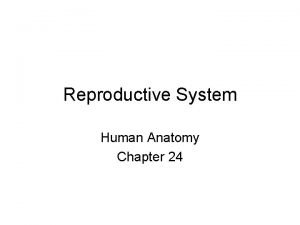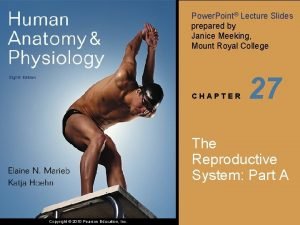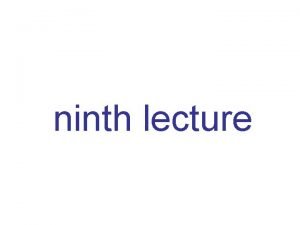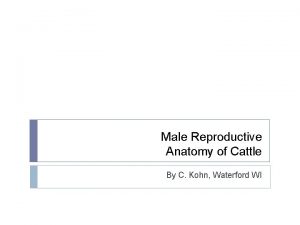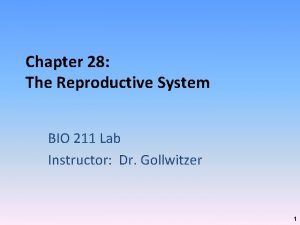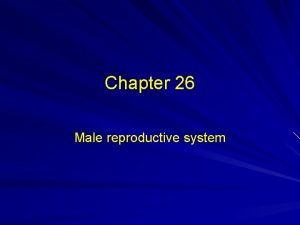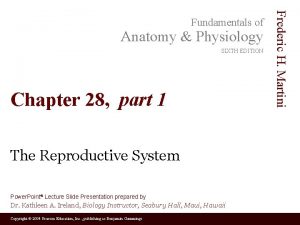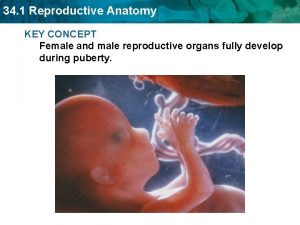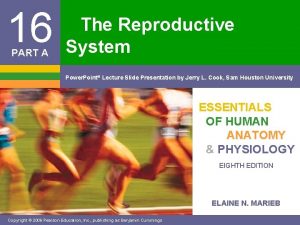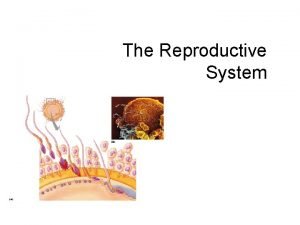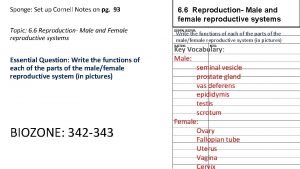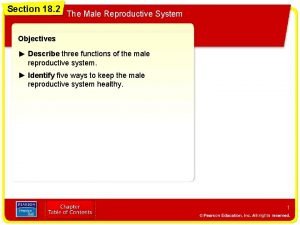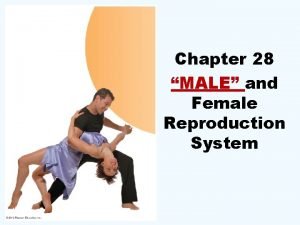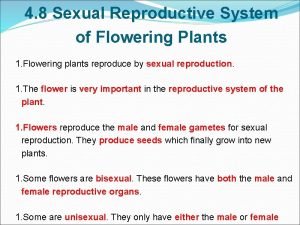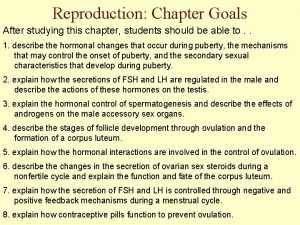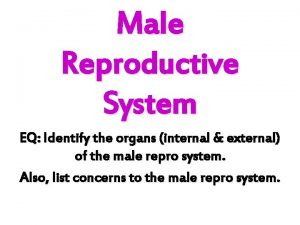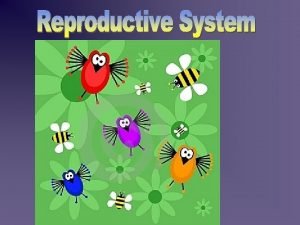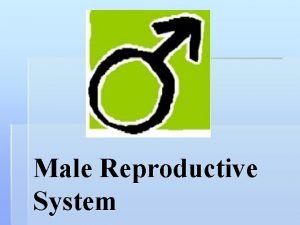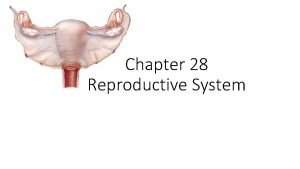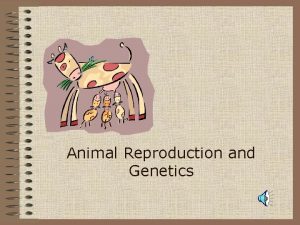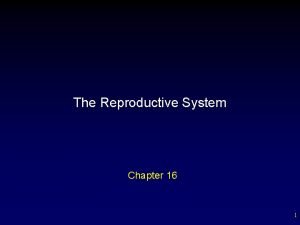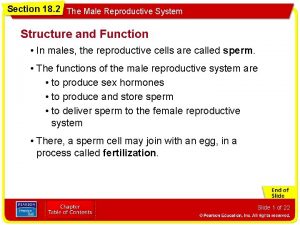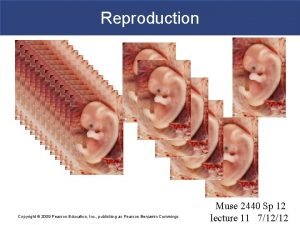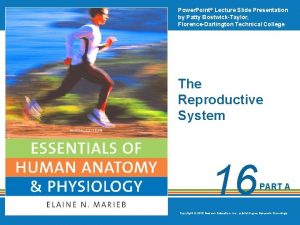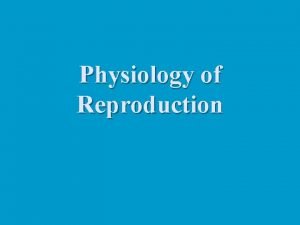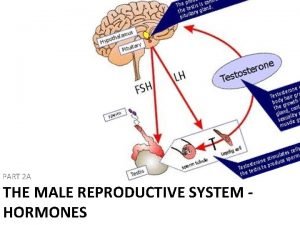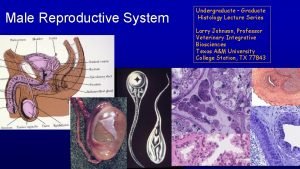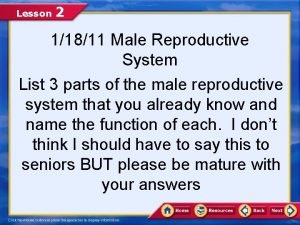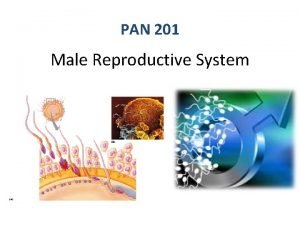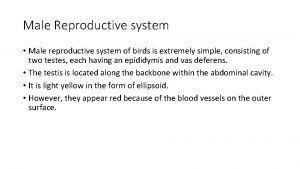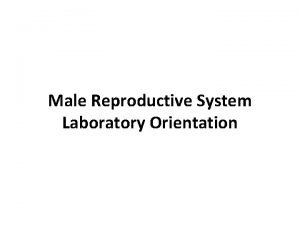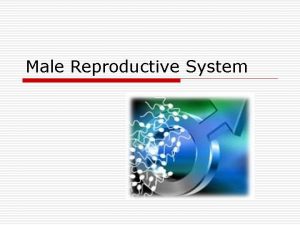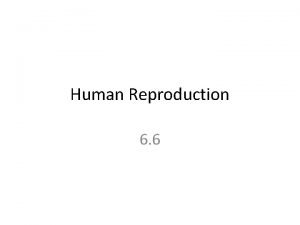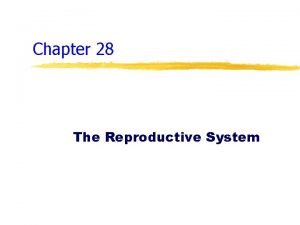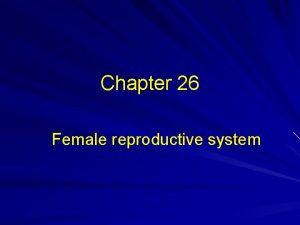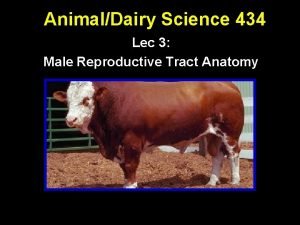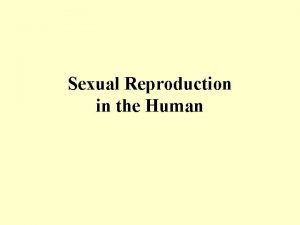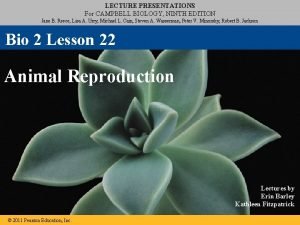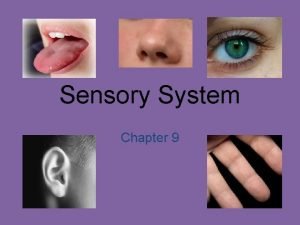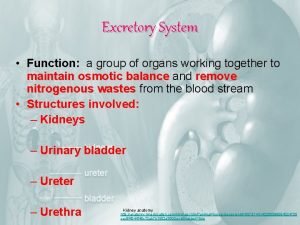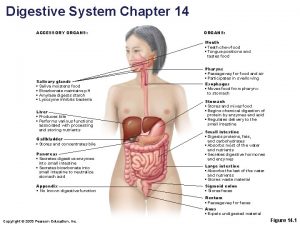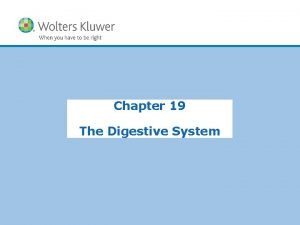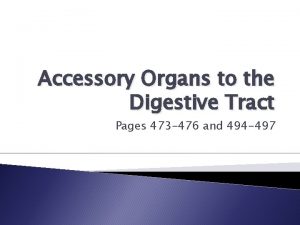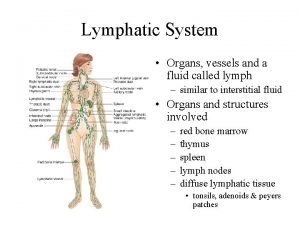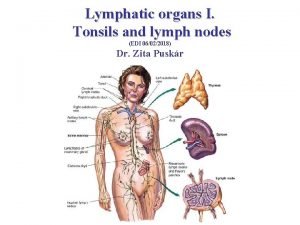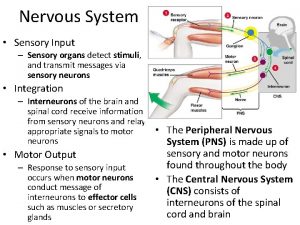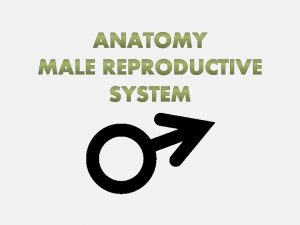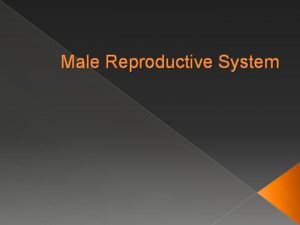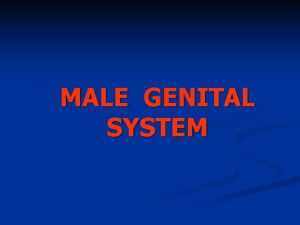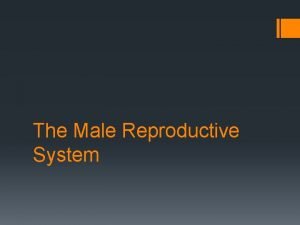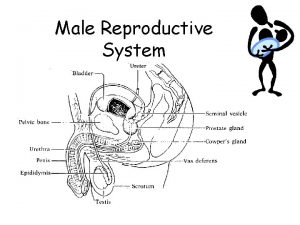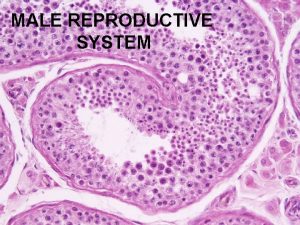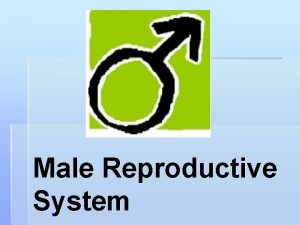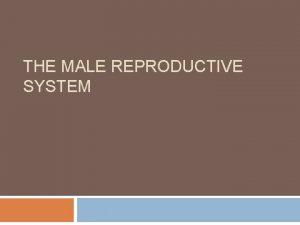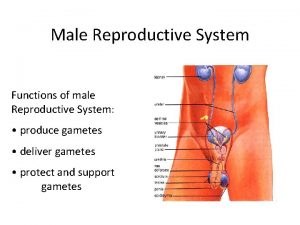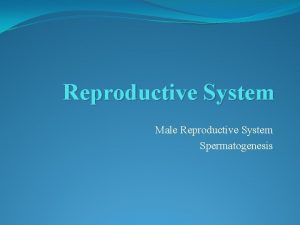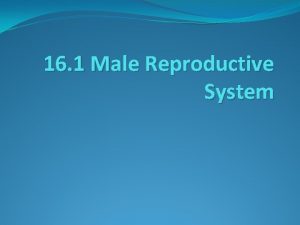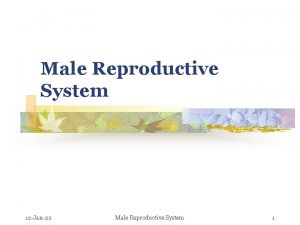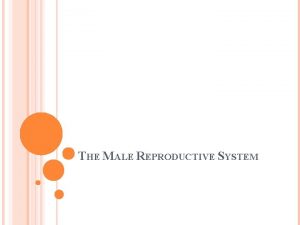Male Reproductive System The organs of the reproductive










































































- Slides: 74

Male Reproductive System

• The organs of the reproductive system are v Internal reproductive organs v. External genital organs

Primary Sex Organs (Gonads) • The primary reproductive organs or gonads consist of a pair of testes in the male and a pair of ovaries in the female. • In both sexes the mature gonads perform the dual function of (1) producing gametes (gametogenesis), that is, spermatozoa (sperm) in the male and ova (eggs) in the female (2) Secreting sex hormones testosterone in males and estrogen and progesterone in females. • In addition to the gonads the reproductive system in each sex includes a reproductive tract which is a system of ducts that are specialized to transport or house the gametes after they are produced plus accessory sex glands that empty their supportive secretions into these passageways

• The major male accessory sex glands whose secretions provide the bulk of the semen are • Seminal vesicles • Prostate gland • Bulbourethral glands

• Sperm exit each testis through the male reproductive tract consisting on each side of an epididymis, ductus (vas) deferens, and ejaculatory duct • These pairs of reproductive tubes empty into a single urethra, the canal that runs the length of the penis and empties to the exterior

• The secondary sexual characteristics are the external characteristics not directly involved in reproduction that distinguish males and females such as body configuration and hair distribution

Physiologic Anatomy • Testis is composed of up to 900 coiled seminiferous tubules, each averaging more than one-half meter long, in which the sperm are formed • The sperm then empty into the epididymis, another coiled tube about 6 meters long • The epididymis leads into the vas deferens, which enlarges into the ampulla of the vas deferens immediately before the vas enters the body of the prostate gland

• Two seminal vesicles one located on each side of the prostate empty into the prostatic end of the ampulla and the contents from both the ampulla and the seminal vesicles pass into an ejaculatory duct leading through the body of the prostate gland • Ejaculatory duct empty into the internal urethra.

• The urethra is the last connecting link from the testis to the exterior • The urethra is supplied with mucus derived from a large number of minute urethral glands located along its entire extent and from bilateral bulbourethral glands (Cowper glands) located near the origin of the urethra

Sertoli Cells • Sertoli cells are large • They are present inside seminiferous tubule • The spermatogenic cells are attached to Sertoli cells by means of cytoplasmic connection • Sertoli cells support and nourish the spermatogenic cells • Secrete Mullerian regression factor • Secrete Inhibin and Activin • Secrete androgen binding protein and estrogen binding protein



Blood-Testis Barrier • It is a mechanical barrier that separates blood from seminiferous tubules of the testes • It is formed by tight junctions between the adjacent Sertoli cells near the basal lamina of seminiferous tubule • It protects the seminiferous tubules and spermatogenic cells by preventing the entry of toxic substances from blood into testis • It permits the nutritive and other essential substances to pass through

Rete Testis • Each seminiferous tubule opens into a network of thin walled channels called Rete Testis

Interstitial Cells of Leydig • These are the hormone secreting cells of the testis situated between the seminiferous tubules

Spermatogenesis • Spermatogenesis occurs in the seminiferous tubules during active sexual life as the result of stimulation by anterior pituitary gonadotropic hormones, beginning at an average of 13 years and continuing throughout most of the remainder of life but decreasing markedly in old age

Spermatogenesis • During formation of the embryo, the primordial germ cells migrate into the testes and become immature germ cells called spermatogonia • The spermatogonia begin to undergo mitotic division beginning at puberty and continually proliferate and differentiate through definite stages of development to form sperm

• In the first stage of spermatogenesis the spermatogonia migrate among Sertoli cells toward the central lumen of the seminiferous tubule • Spermatogonia then become progressively modified and enlarged to form large primary spermatocytes • The primary spermatocytes undergo meiotic division to form two secondary spermatocytes. After few days, these too divide to form spermatids that are eventually modified to become spermatozoa (sperm) • The entire period of spermatogenesis, from spermatogonia to spermatozoa takes about 74 days


Formation of Sperm • When the spermatids are formed they still have the usual characteristics of epithelioid cells but soon they begin to differentiate and elongate into spermatozoa • Each spermatozoon is composed of a head and a tail • On the outside of the anterior two thirds of the head is a thick cap called the acrosome that is formed mainly from the Golgi apparatus. This contains a number of enzymes similar to those found in lysosomes of the typical cell • These enzymes play important role in allowing the sperm to enter the ovum and fertilize it


Hormonal Factors That Stimulate Spermatogenesis • Testosterone ( growth and division of the testicular germinal cells, which is the first stage in forming sperm) • Luteinizing hormone stimulates the Leydig cells to secrete testosterone • Follicle-stimulating hormone stimulates the Sertoli cells, without this stimulation the conversion of the spermatids to sperm (the process of spermiogenesis) will not occur

• Estrogens formed from testosterone by the Sertoli cells when they are stimulated by follicle-stimulating hormone are also essential for spermiogenesis. • Growth hormone (as well as most of the other body hormones) is necessary for controlling background metabolic functions of the testes. Growth hormone specifically promotes early division of the spermatogonia

Other Factors Affecting Spermatogenesis • Increase in body temperature inhibits spermatogenesis ( internal temperature of scrotal sac is 2 degrees centigrade lower than body temperature) • (Regulation of temperature of scrotal testes is brought about by relaxation or contraction of scrotal musculature in summers and winters respectively) • Infections such as mumps cause degeneration of seminiferous tubules

• The two testes of the human adult form up to 120 million sperms each day • A small quantity of these can be stored in the epididymis but most are stored in the vas deferens • The normal motile, fertile sperm are capable of flagellated movement through the fluid medium at velocity of 1 to 4 mm/min • Sperm can live for many weeks in the male genital ducts, once they are ejaculated in the semen, their maximal life span is only 24 to 48 hours at body temperature. At lowered temperatures semen can be stored for several weeks

Function of Seminal vesicles • Each seminal vesicle is a tortuous, loculated tube lined with a secretory epithelium that secretes a mucoid material containing an abundance of fructose, citric acid and other nutrient substances as well as large quantities of prostaglandins and fibrinogen (bulk 60% of the semen, nutrition) • During the process of emission and ejaculation each seminal vesicle empties its contents into the ejaculatory duct shortly after the vas deferens empties the sperm

Role of Prostaglandins • Prostaglandins help in fertilization in two ways (1) by reacting with the female cervical mucus to make it more receptive to sperm movement (2) by causing backward, reverse peristaltic contractions in the uterus and fallopian tubes to move the ejaculated sperm toward the ovaries

Function of the Prostate Gland • The prostate gland secretes a thin, milky fluid (30% of the semen) that contains calcium, citrate ion, phosphate ion, a clotting enzyme, and profibrinolysin • Prostatic fluid is alkaline in nature • Slightly alkaline prostatic fluid helps to neutralize the acidity of the other seminal fluids during ejaculation and thus enhances the motility and fertility of the sperm

• Capacitation of spermatozoa is required for fertilization of the ovum • Spermatozoa when they leave the epididymis, their activity is held in check by multiple inhibitory factors secreted by the genital duct epithelia. • On coming in contact with the fluids of the female genital tract multiple changes occur that activate the sperm for the final processes of fertilization. These collective changes are called capacitation of the spermatozoa. This normally requires 1 to 10 hours

Capacitation • The uterine and fallopian tube fluids wash away the various inhibitory factors that suppress sperm activity in the male genital ducts • The spermatozoa in the fluid of the male genital ducts are continually exposed to many floating CHOLESTEROL vesicles from the seminiferous tubules • This cholesterol is continually added to the cellular membrane covering the sperm acrosome, toughening the membrane and preventing release of its enzymes. • The sperm deposited in the vagina swim away from the cholesterol vesicles upward into the uterine cavity, and they gradually lose much of their other excess cholesterol over the next few hours. • As a result the membrane at the head of the sperm (the acrosome) becomes weaker

• The membrane of the sperm also becomes more permeable to calcium ions • The calcium ions also cause changes in the cellular membrane that cover the leading edge of the acrosome making it possible for the acrosome to release its enzymes rapidly and easily as the sperm penetrates the layers surrounding the ovum

Acrosome Reaction • When the sperm reaches the zona pellucida of the ovum, the anterior membrane of the sperm binds specifically with receptor proteins in the zona pellucida • The entire acrosome rapidly dissolves and all the acrosomal enzymes are released. Within minutes these enzymes open a pathway for passage of the sperm head through the zona pellucida to the inside of the ovum. Within another 30 minutes the cell membranes of the sperm head and of the oocyte fuse with each other to form a single cell

Why Does Only One Sperm Enter the Oocyte? • Within a few minutes after the first sperm penetrates the zona pellucida of the ovum, calcium ions diffuse inward through the oocyte membrane and cause multiple cortical granules to be released by exocytosis from the oocyte into the perivitelline space. These granules contain substances that permeate all portions of the zona pellucida and prevent binding of additional sperm and they even cause any sperm that have already begun to bind to fall off

Cryptoorchidism • Failure of a testis to descend from the abdomen into the scrotum at or near the time of birth of a fetus

• Male sex hormones (androgens) secreted by the testes are Ø Testosterone(most abundant) Ø Dihydrotestosterone Ø Androstenedione

• Testosterone that becomes fixed to the tissues is converted within the tissue cells to dihydrotestosterone especially in certain target organs such as the prostate gland in the adult and the external genitalia of the male fetus • Some actions of testosterone are dependent on this conversion whereas other actions are not

Chemistry of Androgens • All androgens are steroid compounds • Both in the testes and in the adrenals, the androgens can be synthesized either from cholesterol or directly from acetyl coenzyme. A

• Testosterone is sereted from the interstitial cells of Leydig which lie in the interstices between the seminiferous tubules and constitute about 20 percent of the mass of the adult testes • Leydig cells are almost nonexistent in the testes during childhood • These cells are numerous in the newborn male infant for the first few months of life and in the adult male after puberty • At both these times the testes secrete large quantities of testosterone

• 97% of the Testosterone is in the bound form with albumin and sex hormone binding globulin • In certain target tissues much of the Testosterone is converted to Dihydrotestosterone such as in prostate gland in the adult and external genitalia of the male fetus

Degradation and Excretion of Testosterone • The testosterone that does not become fixed to the tissues is rapidly converted by the liver into androsterone and dehydroepiandrosterone and simultaneously conjugated as either glucuronides or sulfates. These are excreted either into the gut by way of the liver bile or into the urine through the kidneys.

Production of Estrogen in the Male • The concentration of estrogens in the fluid of the seminiferous tubules is quite high and plays an important role in spermiogenesis. This estrogen is believed to be formed by the Sertoli cells by converting testosterone to estradiol • Much larger amounts of estrogens are formed from testosterone androstanediol in other tissues (such as skin and adipocytes) especially the liver accounting for as much as 80 percent of the total male estrogen production

• Testosterone is responsible for the distinguishing characteristics of the masculine body • During fetal life the testes are stimulated by chorionic gonadotropin from the placenta to produce moderate quantities of testosterone throughout the entire period of fetal development and for 10 or more weeks after birth • No testosterone is produced during childhood until about the ages of 10 to 13 years. • Testosterone production increases rapidly under the stimulus of anterior pituitary gonadotropic hormones at the onset of puberty and lasts throughout most of the remainder of life


Testosterone During Fetal Life • Testosterone is secreted first by the genital ridges and later by the fetal testes and is responsible for the development of the male reproductive organs

Effect of Testosterone to Cause Descent of the Testes • The testes descend into the scrotum during the last 2 to 3 months of gestation when the testes begin secreting reasonable quantities of testosterone

Puberty • Puberty is usually referred to as maturation of reproductive system and the development of secondary sexual characteristics • The average for onset of puberty is between 10 -13 years • First change at puberty is enlargement of testes and scrotum becomes pigmented and rugose • This is followed by increase in the size of penis, appearance of pubic hair (pubarche), enlargement of accessory sex glands, appearnce of secondary sexual characteristics • Early morning erections and discharge of seminal fluid start taking place • An acceleration of linear growth and increase in body weight

Puberty (cont) • The hormones responsible for the start of puberty changes are the androgens (especially Testosterone) secreted by the testes • The adrenal cortex also starts contributing androgens (adenarche-increase in androgen production at the onset of puberty)

Effect of Testosterone on Development of Adult Primary and Secondary Sexual Characteristics • After puberty increasing amounts of testosterone secretion causes the enlargement male genital organs • Testosterone causes the secondary sexual characteristics of the male to develop, beginning at puberty and ending at maturity

Effect on the Distribution of Body Hair • Testosterone causes growth of hair (1) over the pubis (2) upward along the linea alba of the abdomen sometimes to the umbilicus and above (3) on the face (4)on the chest

Baldness • Testosterone decreases the growth of hair on the top of the head • Baldness is a result of two factors o a genetic background o superimposed on this genetic background large quantities of androgenic hormones

Effect on the Voice • Testosterone causes hypertrophy of the laryngeal mucosa and enlargement of the larynx. • This causes at first a relatively discordant, cracking voice but this gradually changes into the typical adult masculine voice

• Testosterone Increases Thickness of the Skin and Can Contribute to Development of Acne Testosterone also increases the rate of secretion of the body's sebaceous glands

• Testosterone Increases Protein Formation and Muscle Development • Protein anabolic effect • Testosterone Increases Bone Matrix and Causes Calcium Retention

• Testosterone has a specific effect on the pelvis (1) narrow the pelvic outlet (2) lengthen it (3) cause a funnel-like shape instead of the broad ovoid shape of the female pelvis (4) greatly increase the strength of the entire pelvis In the absence of testosterone the male pelvis develops into a pelvis that is similar to that of the female

• Testosterone Increases Basal Metabolic Rate • Testosterone Increases Red Blood Cells • Testosterone causes sodium and water retention

• Testosterone increases rate of linear bone growth but also causes closure of epiphysis

Mechanism of Action Testosterone stimulates production of proteins in target organs or tissues Testosterone binds to the cytoplasmic receptor This combination migrates to the cell nucleus where it binds with a nuclear protein and induces DNA-RNA transcription

Control of Male Sexual Functions by Hormones from the Hypothalamus and Anterior Pituitary Gland • Role of Ø Gn. RH (Hypothalamus) Ø LH (Ant Pituitary) Ø FSH (Ant Pituitary)

• Gn. RH is secreted intermittently a few minutes at a time once every 1 to 3 hours. • The intensity of this hormone's stimulus is determined in two ways: (1) by the frequency of these cycles of secretion (2) by the quantity of Gn. RH released with each cycle.

• The secretion of LH by the anterior pituitary gland is also cyclical with LH following fairly faithfully the pulsatile release of Gn. RH • FSH secretion increases and decreases only slightly with each fluctuation of Gn. RH secretion • It changes more slowly over a period of many hours in response to longer-term changes in Gn. RH


Human Chorionic Gonadotropin Secreted by the Placenta During Pregnancy Stimulates Testosterone Secretion by the Fetal Testes It circulates both in the mother and in the fetus This hormone has almost the same effects on the sexual organs as LH. During pregnancy if the fetus is a male h. CG from the placenta causes the testes of the fetus to secrete testosterone. This testosterone is critical for promoting formation of the male sexual organs

Puberty and Regulation of Its Onset • During childhood the hypothalamus does not secrete significant amounts of Gn. RH • During childhood the slightest secretion of any sex steroid hormones exerts a strong inhibitory effect on hypothalamic secretion of Gn. RH • At the time of puberty the secretion of hypothalamic Gn. RH breaks through the childhood inhibition and adult sexual life begins

Male Adult Sexual Life and Male Climacteric • Most men begin to exhibit slowly decreasing sexual functions in their late 50 s or 60 s • The decrease in male sexual function is called the male climacteric. • Occasionally the male climacteric is associated with symptoms of hot flushes, suffocation, and psychic disorders similar to the menopausal symptoms of the female

Impotence • In the presence of sexual desire and favorable circumstances the person cannot attain or sustain erection of penis

Hypogonadism &Hypergonadism • Hypogonadism is a condition characterized by reduction in functional activity of the gonads • Hypergonadism is a condition characterized by hyper secretion of sex hormones

Causes of Hypogonadism • Congenital non-functional testes • Cryptorchidism • Pituitary disorder and hypothalamic disorder (hypogonadotropic hypogonadism) • Castration • Defect in androgen receptors Hypogonadism caused by testicular disorders increases gonadotropin secretion (hypergonadotropic hypogonadism)

Causes of Hypergonadism • Tumor of the Leydig cells

Hypogonadism in fetus • When the testes of a male fetus are nonfunctional during fetal life none of the male sexual organs and characteristics develop in the fetus

Hyogonadism after Puberty • The sexual organs regress in size • Prostate and seminal vesicles undergo atrophy • Voice regresses from the bass quality only slightly • There is loss of masculine hair production • Loss of the thick masculine bones • Loss of the musculature • Sexual desires are decreased • Erection can occur but ejaculation is rare

Hypogonadism before Puberty • When a boy loses his testes before puberty a state of eunuchism begins in which he continues to have infantile sex organs and other infantile sexual characteristics throughout life • The height of an adult eunuch is slightly greater than that of a normal man because the bone epiphyses are slow to unite although the bones are quite thin and the muscles are considerably weaker than those of a normal man • The voice is childlike, there is no loss of hair on the head, and the normal adult masculine hair distribution on the face and elsewhere does not occur

Adiposogenital syndrome, Fröhlich syndrome, or hypothalamic eunuchism • It is caused by genetic inability of the hypothalamus to secrete normal amounts of Gn. RH. This is often associated with a simultaneous abnormality of the feeding center of the hypothalamus causing the person to overeat • Obesity occurs along with eunuchism.

Hypergonadism • Interstitial Leydig cell tumors are rare but when they do develop they sometimes produce as much as 100 times the normal quantities of testosterone • In young children such tumors cause rapid growth of the musculature and bones but also cause early uniting of the epiphyses • These tumors also cause excessive development of the male sexual organs, all skeletal muscles, and other male sexual characteristics (early puberty)

• More common than the interstitial Leydig cell tumors are tumors of the germinal epithelium • Because germinal cells are capable of differentiating into almost any type of cell many of these tumors contain multiple tissues, such as placental tissue, hair, teeth, bone, skin, all found together in the same tumorous mass called teratoma. • These tumors often secrete few hormones but if a significant quantity of placental tissue develops in the tumor it may secrete large quantities of h. CG with functions similar to those of LH • Estrogenic hormones are sometimes secreted by these tumors and cause the condition called gynecomastia (overgrowth of the breasts)
 Genital development
Genital development Function of vagina
Function of vagina Male function
Male function Development of female reproductive system
Development of female reproductive system Exercise 42 anatomy of the reproductive system
Exercise 42 anatomy of the reproductive system Oogenesis diagram
Oogenesis diagram Function of fsh
Function of fsh Parts of male and female reproductive system
Parts of male and female reproductive system Pearson education
Pearson education Luteinizing hormone in male reproductive system
Luteinizing hormone in male reproductive system Male plant reproductive system
Male plant reproductive system Art-labeling activity: the male reproductive system, part 1
Art-labeling activity: the male reproductive system, part 1 Male reproductive system information
Male reproductive system information Where is sperm stored
Where is sperm stored Functions of testis
Functions of testis Prostate anatomy
Prostate anatomy Male reproductive system plants
Male reproductive system plants Function of male reproductive system
Function of male reproductive system Fish reproductive system
Fish reproductive system In pila fertilization is
In pila fertilization is Fetal pig masseter muscle
Fetal pig masseter muscle Female part of a flower
Female part of a flower Figure 28-2 the female reproductive system
Figure 28-2 the female reproductive system Base of prostate gland
Base of prostate gland Chapter 20 reproduction and pregnancy
Chapter 20 reproduction and pregnancy Female cow reproductive system
Female cow reproductive system Pearson
Pearson Colon function in male reproductive system
Colon function in male reproductive system Figure 16-1 male reproductive system
Figure 16-1 male reproductive system Differences between male and female reproductive organ
Differences between male and female reproductive organ Female reproductive system label
Female reproductive system label Pathway of semen
Pathway of semen 90/2
90/2 Plants reproductive system
Plants reproductive system Summary of male reproductive system
Summary of male reproductive system Diagram of the women's reproductive organs
Diagram of the women's reproductive organs Tunica albuginea
Tunica albuginea What is seminal vesicle in male reproductive system
What is seminal vesicle in male reproductive system Where does mitosis occur in the female reproductive system
Where does mitosis occur in the female reproductive system What is reproductive system
What is reproductive system Uterine orifice
Uterine orifice Basic animal reproduction crossword
Basic animal reproduction crossword Chapter 16 lesson 2 the male reproductive system
Chapter 16 lesson 2 the male reproductive system Parturition
Parturition Male reproductive system side view
Male reproductive system side view Reproductive system function
Reproductive system function Figure 28-1 the male reproductive system
Figure 28-1 the male reproductive system Figure 16-2 is a longitudinal section of a testis
Figure 16-2 is a longitudinal section of a testis Masoderm
Masoderm What are primary sexual characteristics
What are primary sexual characteristics Spermatid
Spermatid Lesson 2 the male reproductive system
Lesson 2 the male reproductive system Male reproductive system
Male reproductive system What is reproductive system
What is reproductive system Corpus cavernosum
Corpus cavernosum Opuberty
Opuberty Male reproductive system
Male reproductive system Definition of reproductive system
Definition of reproductive system Female reproductive organs sagittal section
Female reproductive organs sagittal section Reproductive organs of the bull
Reproductive organs of the bull Function of reproductive organs
Function of reproductive organs Oogonium
Oogonium Produces pollen grains
Produces pollen grains Ducts in female reproductive system
Ducts in female reproductive system Endocrine system and reproductive system
Endocrine system and reproductive system Sensory system organs
Sensory system organs What is the function of the excretory system
What is the function of the excretory system Major and accessory organs of the digestive system
Major and accessory organs of the digestive system Accessory organs of the digestive system
Accessory organs of the digestive system Accessory organs of the digestive system
Accessory organs of the digestive system Spleen function
Spleen function Lymphatic system organs
Lymphatic system organs Stratified squamous non-keratinized epithelium
Stratified squamous non-keratinized epithelium Lymphatic system organs and functions
Lymphatic system organs and functions Organs of the sensory system
Organs of the sensory system
